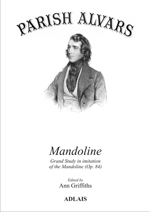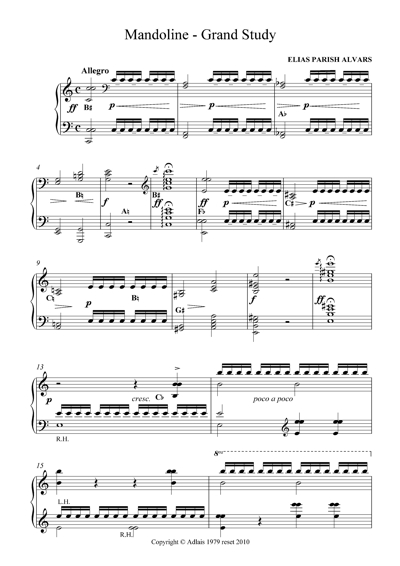 |
|||
| |
of Harp Music |
| © 2004-2025 ADLAIS |
| Mandoline Grand Study in imitation of the mandoline (Op. 84) Elias Parish Alvars (1808-1849) ed. Ann Griffiths |
return to previous page |
 |
Work: | Single work for solo harp |
| Catalogue No: | Adlais 028 | |
| ISMN: | 979-0-57032-160-5 | |
| Edition: | 2010, A4 stapled | |
| Duration: | c. 7' 45 " minutes | |
| Suitable for: | Grade 8, Pedal Harp | |
| Price:: | £12.00 Go to shop | |
| Examination: | LCM Grade 8 List B (2014-2016) | |
| See all Adlais Publications by Elias Parish Alvars | ||
| Grand Study in imitation of the mandoline (Op. 84) |
Parish Alvars spent the winter of 1843-1844 in Naples, and his impressions of the ambience and the typical sights and sounds of that vibrant Mediterranean city are reflected in the series of three pieces he composed there. The Serenade (op. 83) and the brilliant Grand Study in imitation of the Mandoline (op.84) both of which are well known and have figured in the Adlais catalogue for many years. In 2008 Adlais added the genuinely amusing Souvenir of Naples – Il Papagallo (op.85) with its witty characterisation of a pet Neapolitan parrot to the catalogue. About the 2010 Engraving This new edition contains two versions of the work. Version 1: Original Version. This 2010 engraving is an exact replica of the 1979 Adlais Edition taken from the John Thomas Lamborn Cock Edition. Version 2: Enharmonic Transcription. This 2010 engraving is a new Enharmonic Transcription by Ann Griffiths
Notes from the new edition: Mandoline - Enharmonic Transcription Parish Alvars spent the winter of 1843-1844 in Naples, and his impressions of the ambience and the typical sights and sounds of that vibrant Mediterranean city are reflected in the series of pieces that he wrote there, and which were published by Ricordi in Milan in 1846. Three of these pieces, Serenade (op.83), Il Papagallo (op.85) and the present Mandoline (op.84) are included in the collection of works by Parish Alvars which was made by the harpist John Thomas when he was a student at the Royal Academy of Music (1840-46). It was some twenty years later that his revised edition of Mandoline, originally entitled Gran/ STUDIO/ ad imitazione del Mandolino/ per/ L'ARPA / e dedicato alla sua allieva/LA CONTESSA ESTERHAZY/nata Contessa Bathyany was published in London by the firm of Lamborn Cock. Newly engraved in 2010, the present reissue of Mandoline (pages 1-20) is an exact replica of the edition John Thomas made for Lamborn Cock, except that the pedal indications inserted in the 1974 edition have been retained. Parish Alvars had attempted to reproduce the typical 'tremolo' effect of the mandoline by his clever use of the enharmonic synonyms available on Sebastian Erard's double-action harps. The brilliant effect which to the listener appears to be a rapid reiteration of the same note on the same string is in fact achieved by playing its enharmonic equivalent on two adjacent strings. This is done by pre-setting the harp's pedals, so that E, for example, is doubled by playing Fb E natural in quick succession; C is doubled by setting B#. Interpretation of the notational 'shorthand' convention which John Thomas adopted in order to indicate the use of enharmonic synonyms is not instantly obvious and has caused difficulty, frustration and confusion to generations of harpists wishing to play this delightful piece. A performing edition with an instant solution would have been warmly welcomed by generations of teachers and students alike, but no such edition has ever been produced before. Hopefully, the solution proposed by Adlais in this volume will fulfil that need. Pages 1-20 retain the original 1974 edition, whilst pages 23-42 are new, and contain a literal note-for-note enharmonic transcription of the whole work, bar for bar, page for page. Comparisons between the 'original' and the 'solution' are thus facilitated, and both 'old' and 'new' are contained in the same volume. Whilst we offer our harmonic solution in all humility, we hope it will encourage many more harpists to play Parish Alvars's brilliantly evocative musical souvenir of mid-nineteenth-century Naples, his Grand Study in Imitation of the Mandoline. Adlais, May 2010 |




